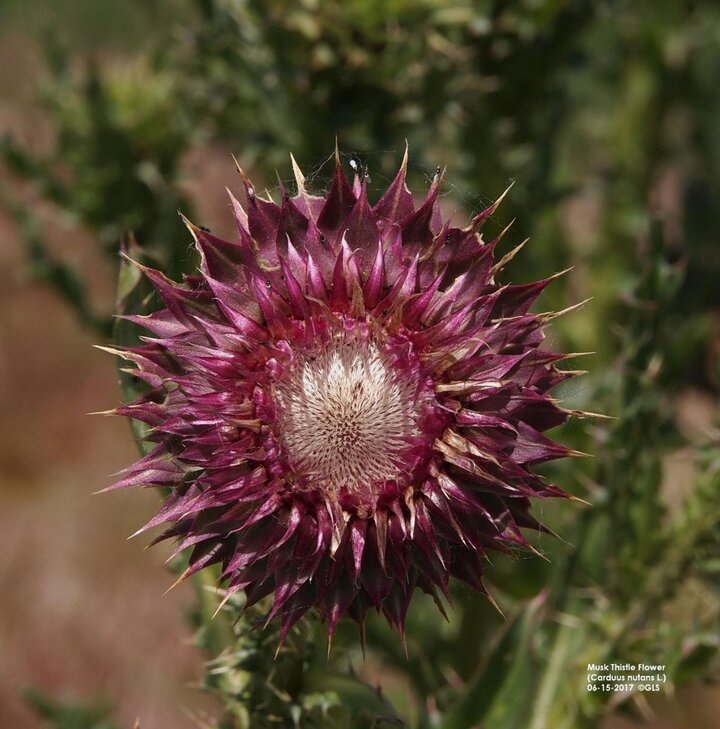Fall Thistle Control
Did you spray thistles this past spring and summer? If so, it would be a good idea to revisit those areas as there are likely some remaining or new growth that has occurred. October and early November is a key time to control thistles in pastures.

There are several biennial thistles, but musk, plumeless, Scotch and bull thistles are our most problematic. Biennials require portions of two growing seasons to flower/reproduce. They develop from seed the first season into a flat rosette. When trying to control biennial thistles, destruction of rosettes prior to flowering (bolting) is an effective means of preventing seed formation and subsequent spread.
Another thistle to look out for is Canada thistle. Canada thistle is a creeping perennial that can be controlled with fall spraying, in conjunction with other management options in the spring.
While in the rosette stage, thistles are more effectively controlled using herbicides. It is important to note that fall spraying of thistles is not a silver bullet and effective control often needs repeated applications. It will take several years of timely control before the soil seed bank is reduced. There are many herbicides labeled for thistle control. Note that some products traditionally recommended for spraying thistles have recently changed product names. Take care when purchasing products and always read/follow label directions before use.
GrazonNext® HL, Milestone®, Chaparral®, Graslan® L, Stinger®, Overdrive® and Tordon 22K® are all products that are labelled for use on biennial thistles, as well as Canada thistle. 2,4-D mixed with dicamba is also an effective option but should be sprayed when temperatures are warmer for the highest efficacy. When using Tordon 22K® or Graslan® L, both products are restricted use and contain picloram. Use extreme caution around other vegetation, especially trees, as both products will kill woody plants.
Fall Armyworms
Fall armyworms are continuing to be a problem in the eastern half of Nebraska, causing significant damage to pastures and alfalfa fields. Unfortunately, the story is the same — producers watching a nice pasture or field nearly completely eaten down or turning brown in a matter of a few days by these pests. This is creating concern about newly seeded alfalfa, newly seeded small grains and emerging cover crops.
We have seen a large population of fall armyworm caterpillars this year, feeding on a wide host of crops and forages, doing most of their feeding and damage in the last four days of their larvae development. Because of this, it is very important to scout fields and pastures regularly in the early morning and late afternoon when caterpillars are most active, to spot them when they are small. Once caterpillars are ¾ inch, they can do considerable damage in a few days. With winter around the corner, we want to make sure our pastures and winter crop fields have adequate time to prepare for a freeze. Severe damage now could impact the plant’s ability to winterize, leading to yield and stand issues next year. You also might consider delaying planting your winter wheat until early October.
Remember, a reasonable treatment threshold is finding three or more caterpillars per square foot within a field or pasture. There are several insecticides labeled to control this pest. Mustang Maxx, Besiege and Sevin can be used on pastures, alfalfa, small grains and cover crops, but always read and follow the label. For forage crops, be sure to check the grazing restriction and post-harvest interval. When considering a chemical treatment option, keep in mind caterpillars ¾ inch or longer are close to maturity and can be harder to control with an insecticide.
With cooler temperatures, fall armyworms feeding should slow down and the adult moths will eventually migrate south as they can’t survive Nebraska winters. Sadly, we don’t know for sure when that will happen. In the meantime, be sure to keep an eye on your pastures and newly seeded fields.
Soybean Residue for Forage
By Brad Schick
Many soybean fields have already been harvested. Cows are often put on soybean residue in order to get them off pasture when other forage options are unavailable. Soybean residue or stubble may also be baled and used in rations. But what is the quality of grazed or baled soybean residue?
Soybeans themselves are very high in protein and fat. They are about 40% crude protein and about 20% fat, which is why soybean residue can be perceived as great feed. However, the residue itself has a much different feed composition. The empty pods and stems contain only 4% to 6% CP and the TDN is only 35% to 45%. The leaves are slightly higher in protein at 12%, but the protein is only 30% digestible and leaves break down quickly after plants reach maturity and harvest has taken place.
These feed values will not begin to support the nutritional requirements of a dry cow even if there is some grain left in the field. Soybean residue can be grazed and would work to remove cattle from pasture as long as supplemental feed is provided.
Baled residue can be worked into a ration once the quality of the soybean residue bales is determined. Bales can be used as a roughage source in rations if other sources are less available. Just like grazing, baled soybean residue does not even come close to providing the feed value of corn stalk bales.
Soybean residue may not be the quality we often think. Residue alone will not meet even a dry cow’s nutrient requirements, so supplementation will be needed if you decide to utilize your soybean residue.
